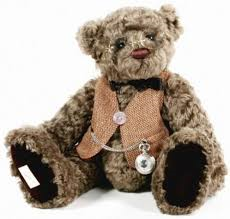 Beginnings: Rag Books
Beginnings: Rag Books
Dean’s didn’t start out as a teddy bear maker. Instead it began its life as Dean’s Rag Book Company, founded by Henry Dean in 1903, to make brightly colored rag books for children. The books were virtually indestructible, as illustrated by Dean’s trademark showing a bulldog and a terrier fighting over a rag book, illustrated by artist Stanley Berkley. The books could be washed if they accumulated too much food or mud, or taken to bed and hugged since they were cloth.
But Dean’s expertise in printing, patterns and cloth made them a natural to branch out into the world of soft toys, including teddy bears, which they eventually did. It is said that Deans made teddy bears as early as 1906, but if they did, they weren’t labeled and so can’t be proven.
Dean’s Bears Are Born
What is known is that Dean’s first plush teddy bear was born in 1915, thus making Dean’s one of the oldest teddy bear makers in England (Chad Valley bears were also born in 1915), filling the void for teddy bears caused by World War I hostilities and the ban of imports from Germany. The teddies, under the name “Kuddlemee,” had long jointed limbs and pointed ears. They were made in Dean’s factory in the Elephant & Castle district of London, where the company had moved from their Fleet Street location in 1912.
However, Dean’s didn’t begin large-scale production of teddy bears until the 1920’s since dolls were their main focus. In 1922 Dean’s registered the trademark A1 Toys for a group of toys that included plush mohair teddy bears with either a squeaker or growl box.
Dean’s teddy bears of this period resembled the typical British teddies with a triangular shaped flat head, an oval black stitched nose, large flat ears and thick-set curved arms and stocky legs and feet; both paws and feet have stitched claws.
Dean’s most productive period was the 1930’s, in which it introduced a bear made of art silk instead of mohair, made in two sizes and assorted colors. So popular was the “Silkeen Teddy” that for five years (1932-37) Dean’s didn’t use mohair for their teddies at all. Dean’s also introduced its mousy teddy with round head and wide floppy ears set on the side, a model that continued into the 1950’s.
Post-War Bears
The company moved to a specially built factory in Merton, Surrey, in southwest London, in 1937. They almost stopped producing soft toys during World War II, instead making military supplies such as life jackets. The post-war period was also difficult as people were more concerned about getting back to a normal life than they were with buying toys. Dean’s struggled and it wasn’t until 1949 that they issued a new catalog. But they rebounded and with an organized sales force were soon back on their feet.
Dean’s also joined the polar bear craze beginning in 1949 with the birth of the first polar bear cub in the London Zoo. Named Brumas, the little cub spurred a demand for white teddy bears. Dean’s produced a mother polar bear called Ivy, along with a cub, to celebrate the event. Many manufacturers, including Dean’s, also made white teddy bear hand puppets, possibly a tribute to Brumas. Dean’s also introduced “Tru-to-Life” in 1955, a stuffed black grizzly bear with floppy limbs that allowed him to sit or stand on all fours with the help of a collar and lead.
Dean’s Moves to a New Location
In 1956 the company moved from Merton to new quarters in Rye, Sussex, and Sylvia Willgoss succeeded Richard Ellett as head designer. Ellett had been responsible for Dean’s very popular velvet bears. First introduced in the 1930’s, these bears were not jointed and wore velvet clothes which cut down on the amount of mohair needed during the war years when those materials were in short supply.
The 1960’s and ‘70’s were periods of change for Dean’s Rag Book Company. The factory in Rye was extended in 1961. The company used the Childsplay Ltd label until 1965 when Childsplay Ltd (a division of Dean’s from the 1950’s, along with Merton Toys Ltd) became Deans Childsplay Ltd; the logo of the two fighting dogs was dropped shortly thereafter.
In 1972 Dean’s bought Gwentoys, but continued making their brand of teddy bears, which was heavily influenced by Chad Valley (Gwentoys was started by three managers who had come from Chad Valley). Gwentoys teddies had rounded muzzles protruding from their faces, and the short limbs, round feet and lack of claws that were typical of British teddies of the 1960’s. And although the limbs were jointed, the necks weren’t, for Gwentoys teddies were made for the cheaper markets of chain stores and mail order catalogs.
Two years later, in 1974, Dean’s moved its production facility from Rye to Pontypool in south Wales; the Rye plant was eventually closed in 1980.
Changes
But even with all the changes, Dean’s was able to survive the upheavals in the teddy bear and soft toy market that occurred in the 1970’s, due in part to the introduction of cheap teddy bears made in the Far East.
But disaster was about to strike. In 1986 Dean’s was bought by Plaintalk, a toy and gift exporter. But that arrangement didn’t last long and by 1988 Dean’s was in liquidation. Dean’s, however, was saved by Neil Miller, a former employee who organized a management buyout, and Dean’s was once more in business with its original trademarks and logo of the two fighting dogs.
Sadly, however, Dean’s closed in April 2015, and their bears were retired—but not forgotten. For Dean’s bears live on as highly prized collectors’ items.
